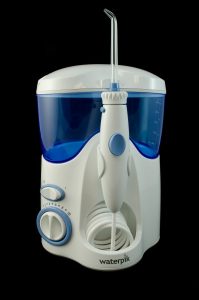
A water flosser is a handheld device that removes food and plaque between teeth using streams of water that are sprayed in steady pulses. According to the American Dental Association, using a water flosser doesn’t replace brushing and manual flossing, it’s a supplement to them, removing the food and plaque that can cause cavities and gum disease, especially for those that find flossing difficult or for those with braces, dental implants, crowns, bridges, and veneers. Today’s market size shows worldwide water flosser revenues for 2018 and projected for 2025.
According to the World Health Organization, untreated tooth decay is the most common health condition in the world. An estimated 2.3 billion people have dental cavities in their permanent teeth and 530 million children have them in their primary teeth. Ten percent of the population has severe periodontal disease.
Dental cavities result when plaque forms on the surface of a tooth and converts sugars from food into acid that destroys the tooth over time. Several social conditions contribute to the rising prevalence of dental cavities, periodontal disease, and other oral diseases, especially in low- and middle-income countries. The lack of fluoride in water and in oral hygiene products, poor access to oral health care services, the marketing of food and beverages high in sugar content and tobacco and alcohol use all contribute to poor oral health.
An aging population, an expanding medical tourism sector and the increasing urbanization of the population in many parts of the world along with growing awareness of oral health as an aspect of overall health is expected to contribute to this product’s revenue growth. As well, increasing demand for professional dental care due to the effects of diabetes worldwide and increasing tobacco consumption in places such as India and China will lead to growth in this market. North America was the largest market in 2018 and is expected to continue to be so through 2025. The Asia-Pacific region is expected to be the fastest-growing market over this time period.
In 2018, dental clinics accounted for more than 55% of revenues, followed by hospitals. Water flossers for in-home use comprised only about one-eighth of total revenues. But, with the increasing cost of professional dental treatments, in-home water flosser revenue is expected to grow the fastest through 2025, at a compound annual growth rate of 5.2%. Leading manufacturers of water flossers include Shenzhen Relish Technology Co., Ltd.; Hydro Floss; Water Pik, Inc.; ToiletTree Products, Inc.; Ginsey Home Solutions; Oral Breeze; Koninklijke Philips N.V.; Procter & Gamble; Aquapick; and S. C. Johnson & Son, Inc.
Geographic reference: WorldYear: 2018 and 2025
Market size: $806.52 million and $1.11 billion
Sources: “Water Flosser Market Size, Share & Trends Analysis Report by Application (Home Care, Dental Clinic, Hospitals), by Product (Countertop, Cordless), by Region (APAC, Europe, MEA, North America), and Segment Forecasts, 2019 – 2025,” Grand View Research Report Summary, July 2019 available online here; “Water Flosser Market Size Worth $1.11 Billion By 2025 | CAGR: 4.7%,” Grand View Research Press Release, July 2019 available online here; “Oral Health,” World Health Organization, March 25, 2020 available online here; “Water Flossing,” Mouth Healthy, Amerian Dental Association available online here.
Image source: Waterpikinc, “File:Water Flosser.jpg,” Wikimedia Commons, March 23. 2011 available online here. Use of photo does not constitute an endorsement.
